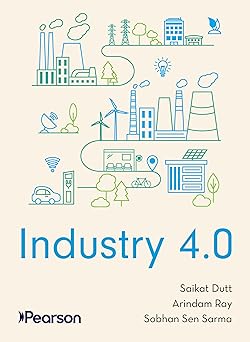Alumni Author: Industry 4.0 – Arindam Ray, PGP 2007
IIM Bangalore alumnus Arindam Ray has built a remarkable career at the crossroads of technology, strategy, and human impact. After leading large-scale digital transformation initiatives at Tech Mahindra and Infosys, he transitioned into academia to explore the ethical and societal dimensions of artificial intelligence. Today, as a researcher and educator, Arindam continues to bridge corporate experience with academic inquiry, helping shape the next generation of leaders in the era of Industry 4.0 and beyond.
Can you share your journey since graduating from IIMB and how it has shaped your professional and academic career?

After graduating from IIM Bangalore, my journey has been one of connecting technology, people, and strategy. Before joining IIMB, I had already spent eight years in the technology industry, which gave me hands-on exposure to implementation challenges and large-scale enterprise systems. My time at IIMB helped me step back and see the bigger picture – how technology, business, and human factors intersect in driving transformation.
Post-IIMB, I continued with Tech Mahindra, where I led the Digital Workplace practice, scaling it over 40× in revenue and building a 300+ member team in less than a decade. Later, at Infosys, as part of the CXO strategy office, I focused on workforce transformation, productivity analytics, and the human side of digital delivery. These experiences deepened my understanding of how organizations evolve in the digital era.
Eventually, my curiosity about artificial intelligence and its societal impact drew me into academia. I pursued an MS in Analytics at Georgia Institute of Technology and later a Ph.D. in Information Systems at the University of South Florida, where I began researching the broader implications of AI in business and society. This blend of corporate and academic experiences now shapes how I teach, research, and engage with industry – combining strategic insight with technological depth.
What inspired you to write your recent book on Industry 4.0, and what key message do you hope readers will take away from it?
The idea for Industry 4.0 came from observing the confusion many professionals and students face when trying to connect the dots between technology buzzwords like IoT, AI, cloud, and robotics. Having seen digital transformation from both the industry and academic perspectives, I and my co-authors, Saikat Dutt (Professor of Practice, IIM Calcutta) and Sobhan Sen Sarma (General Manager, Ericsson), wanted to write a book that simplifies the complexity of Industry 4.0 while showing its real-world applications. The book uses practical examples, diagrams, and over 400 practice questions to make the subject approachable for both students and practitioners.
The core message is that Industry 4.0 is not just about technology. True transformation happens when cyber-physical systems, people, and processes work together to create adaptable, data-driven, and sustainable organizations.
In your opinion, which Industry 4.0 technologies hold the most transformative potential for Indian industries, and why?
It is not any one technology that holds the key to transformation, but rather how multiple technologies come together to create connected, intelligent, and adaptive systems. The true power of Industry 4.0 lies in the convergence of IoT, AI, analytics, cloud, robotics, and additive manufacturing – working seamlessly through cyber-physical systems.
Still, if we look at what is being adopted more widely and showing tangible impact in Indian industries today, Industrial IoT, AI-driven analytics, and additive manufacturing stand out.
• Industrial IoT (IIoT) enhances transparency and traceability across fragmented supply chains, enabling real-time monitoring and smarter decision-making.
• AI and advanced analytics help businesses move from reactive problem-solving to predictive and prescriptive intelligence – optimizing maintenance, quality, and resource utilization.
• Additive manufacturing (3D printing) is accelerating localized, on-demand production and reducing design-to-market cycles, particularly valuable for SMEs and engineering-driven sectors.
The real opportunity for Indian firms lies in orchestrating these technologies cohesively, leveraging connectivity, intelligence, and flexibility, to overcome legacy constraints and build globally competitive, digitally resilient operations.


Having engaged with industries and academia in both India and globally, what key differences and similarities do you observe in how Industry 4.0 technologies are adopted and implemented, and what lessons can Indian industries learn from global practices?
Globally, I’ve seen Industry 4.0 adoption as part of a strategic, innovation-based approach – companies collaborate closely with universities, startups, and technology partners. There’s long-term investment in R&D and capability building.
In India, adoption tends to be more pragmatic and cost-driven, focused on immediate ROI and operational efficiency. This often leads to successful pilots but slower enterprise-wide transformation.
The opportunity for India lies in combining its strength in pragmatic implementation with a strategic roadmap – building scalable, sustainable ecosystems through a chain of small implementations. Indian firms can also benefit from closer academia–industry partnerships to accelerate innovation, as seen in the U.S. and Europe.
What role do you think educational institutions like IIMB can play in preparing the next generation of leaders for the challenges of Industry 4.0?
Institutions like IIMB can play a pivotal role by fostering digital fluency, systems thinking, and interdisciplinary learning. Future leaders must understand how data, technology, and human behavior come together to shape organizational performance. IIMB can also strengthen experiential learning through live projects, innovation labs, and partnerships with industry undergoing digital transformation.
Most importantly, management education should emphasize the ethical and societal dimensions of AI and automation – helping students balance technological innovation with responsible leadership. Ultimately, the goal should be to develop leaders who can translate technological possibilities into strategic, human-centered outcomes.
Looking ahead, which emerging technologies do you believe will be game-changers in the next phase of Industry 4.0, and why?
The most profound shift we are witnessing today comes from Generative AI, which has changed how humans interact with machines. For decades, people had to learn the language of computers – through programming, query syntax, or structured data inputs. Generative AI reverses that equation by enabling humans to communicate with machines in natural language, making advanced capabilities accessible to everyone, not just technical experts. This democratization of AI is transforming how decisions are made, giving rise to AI-augmented decision systems that combine human intuition with machine intelligence for faster, more data-driven, and context-aware insights.
Beyond Generative AI, edge computing and 5G are reshaping how data is processed – bringing intelligence closer to the source, whether in factories, logistics hubs, or retail environments. This allows real-time responsiveness, lower latency, and more secure, localized analytics – critical for applications like autonomous systems and predictive maintenance.
We are also moving toward bio-digital convergence, where technologies such as haptic systems, digital twins of humans, and neuro-digital interfaces are blurring the boundaries between the physical and digital worlds. This convergence opens new possibilities in healthcare.
Finally, quantum computing, though still emerging, promises to revolutionize areas like drug and materials discovery, logistics optimization, financial modelling, grid and energy optimization and climate modelling by solving problems that are computationally infeasible today.
As we move toward Industry 5.0, the focus will shift from pure automation to creating more human-centric, resilient and sustainable production systems.
As an IIMB alumnus, what advice would you offer to current students aspiring to make an impact in technology, academia, or entrepreneurship?
My advice would be to be NICE.
• be nimble. The world of technology and business is evolving faster than ever. Stay adaptable and embrace change rather than resist it. Agility in thought and action will help you stay ahead of disruption and seize emerging opportunities.
• be interdisciplinary. Don’t confine yourself to one domain. The most exciting innovations happen at the intersection of technology, business, and society.
• be curious. Whether you pursue a corporate, academic, or entrepreneurial path, continuous learning is key. Technologies evolve rapidly – your ability to connect ideas will define your success.
• be ethical. Technology is a means to an end. Always ask how your work creates value for people and communities. Build a mindset that values long-term impact over short-term gains and remember that leadership in the digital age is as much about empathy and integrity as it is about innovation.
Arindam Ray’s journey reflects the evolving nature of leadership in the digital age – one that values curiosity as much as expertise and responsibility as much as innovation. His insights remind us that technology’s true purpose lies in enabling people and shaping a more thoughtful, connected, and sustainable world — a vision that continues to resonate strongly within the IIM Bangalore alumni community.


